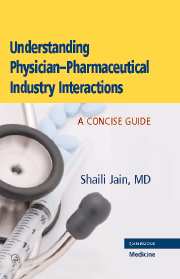Book contents
- Frontmatter
- Contents
- Acknowledgments
- Foreword
- Introduction
- 1 Gifts from the Pharmaceutical Industry to Physicians: Do They Influence your Prescribing?
- 2 Ethical Considerations of Receiving Gifts from the Pharmaceutical Industry
- 3 One on One: An Analysis of the Physician–Pharmaceutical Company Representative (PCR) Detailing Interaction
- 4 Medical Academia and the Pharmaceutical Industry
- 5 Teaching Physicians in Training about Pharmaceutical Industry Promotion
- 6 Continuing Medical Education: How to Separate Continuing Medical Education from Pharmaceutical Industry Promotion
- 7 Professional Policies on Physician–Pharmaceutical Industry Interaction (PPII)
- 8 Preserving Professionalism: Patients' Perceptions of Physicians' Acceptance of Gifts from the Pharmaceutical Industry
- 9 To Sample or Not to Sample? The Use of Pharmaceutical Industry–Supplied Medications in Medical Practice
- 10 Physician–Pharmaceutical Industry Interactions (PPIIs), the Law and the Media
- 11 Direct-to-Consumer Advertising (DTCA)
- 12 Pharmaceutical Industry Interactions with Health Care Professionals: A Global Perspective
- 13 Internet Resources for Teaching about PPII and Independent Sources of Information about Prescription Medicines
- Appendix I
- Appendix II
- Index
- References
1 - Gifts from the Pharmaceutical Industry to Physicians: Do They Influence your Prescribing?
Published online by Cambridge University Press: 03 March 2010
- Frontmatter
- Contents
- Acknowledgments
- Foreword
- Introduction
- 1 Gifts from the Pharmaceutical Industry to Physicians: Do They Influence your Prescribing?
- 2 Ethical Considerations of Receiving Gifts from the Pharmaceutical Industry
- 3 One on One: An Analysis of the Physician–Pharmaceutical Company Representative (PCR) Detailing Interaction
- 4 Medical Academia and the Pharmaceutical Industry
- 5 Teaching Physicians in Training about Pharmaceutical Industry Promotion
- 6 Continuing Medical Education: How to Separate Continuing Medical Education from Pharmaceutical Industry Promotion
- 7 Professional Policies on Physician–Pharmaceutical Industry Interaction (PPII)
- 8 Preserving Professionalism: Patients' Perceptions of Physicians' Acceptance of Gifts from the Pharmaceutical Industry
- 9 To Sample or Not to Sample? The Use of Pharmaceutical Industry–Supplied Medications in Medical Practice
- 10 Physician–Pharmaceutical Industry Interactions (PPIIs), the Law and the Media
- 11 Direct-to-Consumer Advertising (DTCA)
- 12 Pharmaceutical Industry Interactions with Health Care Professionals: A Global Perspective
- 13 Internet Resources for Teaching about PPII and Independent Sources of Information about Prescription Medicines
- Appendix I
- Appendix II
- Index
- References
Summary
Brenda is in a good mood. She has been trying to get an invitation to sponsor breakfast at the internal medicine grand rounds for several weeks and just got a phone call from the grand rounds coordinator, Gloria, confirming an opening for the following week. Brenda is very keen to meet the residents, especially the new PGY 1 class. Experience has taught her that targeting younger physicians who are not set in their prescribing ways pays off. Furthermore, once they start prescribing her medication they tend to stay loyal to the brand. She wants to talk to them about Lowpress, her new medication for the treatment of hypertension. She also enjoys working with residents, as she finds it easy to socialize and chat with them: many of them are similar to her in age and share common interests with her. Hosting breakfast at grand rounds will give her good exposure to the residents. She already knows the caterer she will use; she has overheard the residents raving about the pastries there. Experience has also taught her that well-satisfied stomachs make for better listeners!
In 2000, pharmaceutical companies spent $15.7 billion promoting their products, with 84% directed toward medical promotions via detailing, drug samples and journal ads. Promotional dollars spent on “gifts” for physicians are ubiquitous in medical environments, with one study showing that 97% of residents carried at least one item with a pharmaceutical company logo on it.
- Type
- Chapter
- Information
- Understanding Physician-Pharmaceutical Industry InteractionsA Concise Guide, pp. 1 - 6Publisher: Cambridge University PressPrint publication year: 2007



